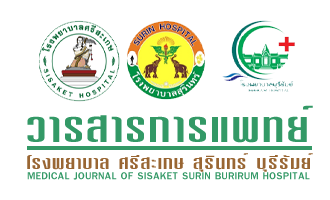ผลการผ่าตัดแก้ไขทางเดินน้ำตาอุดตันในโรงพยาบาลบุรีรัมย์
Main Article Content
บทคัดย่อ
วัตถุประสงค์: เพี่อศึกษาถึงผลสำเร็จของการผ่าตัดแก้ไขทางเดินน้ำตาอุดตัน ด้วยวิธีผ่านทางจมูก โดยไม่ใช้กล้องส่อง (non-endoscopic transnasal DCR) ในโรงพยาบาลบุรีรัมย์
วิธีการ: ทำการศึกษาแบบ retrospective ในผู้ป่วยที่ได้รับการผ่าตัดแก้ไขทางเดินน้ำตาอุดตันด้วยวิธีผ่านทางจมูกโดยไม่ใช้กล้องส่อง ตั้งแต่มีนาคม 2548 ถึงกุมภาพันธ์ 2549 พบว่ามีการผ่าตัดรวม 23 ครั้ง ในผู้ป่วย 15 ราย อายุเฉลี่ย 49.3 ปี (16-71 ปี; SD 16.93 ปี) เป็นหญิง 12 ราย (ร้อยละ 80) ชาย 3 ราย (ร้อยละ 20) เป็นการทำผ่าตัดครั้งแรก (primary DCR) 17 ครั้ง ผ่าตัดซํ้า (revised DCR) หลังจากผ่าตัดท่อน้ำตาอุดตันด้วยวิธีผ่านทางผิวหนัง (external DCR) 2 ครั้ง และผ่าตัดซ้ำหลังจากใช้วิธีผ่าตัดทางจมูกโดยไม่ใช้กล้องส่อง (non-endoscopic transnasal DCR) 4 ครั้ง ประเมินผลสำเร็จของการผ่าตัด โดยดูจากผู้ป่วยไม่มีอาการน้ำตาไหลและสามารถล้างท่อน้ำตาผ่านหลังผ่าตัด 6 เดือน
ผลการศึกษา: ในการผ่าตัดทั้งหมด 23 ครั้ง ผลสำเร็จของการผ่าตัดรวม 19 ครั้ง (ร้อยละ 82.6) ในรายที่เป็นการทำผ่าตัดครั้งแรก (primary DCR) ผ่าตัดสำเร็จ 13 ใน 17 ครั้ง (ร้อยละ 76.5) รายที่เป็นการผ่าตัดซ้ำทั้ง 6 ครั้ง ผ่าตัดสำเร็จหมด
สรุป: non-endoscopic transnasal DCR เป็นอีกทางเลือกหนึ่งในการผ่าตัดแก้ไขท่อน้ำตาส่วนปลายอุดตันในปัจจุบัน โดยไม่ต้องซื้อเครื่องมือราคาแพงเพิ่ม ให้ผลการผ่าตัดดี เมื่อเลือกทำในรายที่เหมาะสม
คำสำคัญ: non-endoscopic transnasal DCR, external DCR, ผลการผ่าตัด
Article Details
เอกสารอ้างอิง
2. Warren JF, Seiff SR, Kavanagh MC. Long-term results of external dacryocystorhinostomy. Ophthalmic Surg Lasers Imaging. 2005 Nov-Dec; 36(6):446-50.
3. Onerci M. Dacryocystorhinostomy. Diagnosis and treatment of nasolacrimal canal obstructions. Rhinology. 2002 Jun;40(2):49-65. Review.
4. Metson R, Woog JJ, Puliafito CA. Endoscopic laser dacryocystorhinostomy. Laryngoscope. I994;i04 (3 pt 1): 269-74.
5. Massaro BM, Gonnering RS, Harris GJ. Endonasal laser dacryocystorhinostomy. A new approach to nasolacrimal duct obstruction. Arch Ophthalmol. 1990;108:1172-6.
6. Gonnering RS, Lyon DB, Fisher JC. Endoscopic laser assisted lacrimal surgery. Am J Ophthalmol. 1991;111:152-7.
7. Patel BC, Phillips B, McLeish WM, Flaharty P, Anderson RL. Transcana-licular neodymium : YAG laser for revision of dacryocystorhinostomy. Ophthalmology. 1997;104:1191-7.
8. Woog JJ, Kennedy RH, Custer PL, et al. Endonasal dacryocystorhinostomy: a report by the American Academy of Ophthalmology. Ophthalmology. 2001;108:2369-77.
9. Nimworapun T, Khamapirud B, et al. Surgical outcomes of nasolacrimal duct obstruction in Ramathibodi hospital. Thai J Ophthalmol. 2005; 19(1):59-65.
10. Tsirbas A, Davis G, Wormald PJ. Mechanical endonasal dacryocystor-hinostomy versus external dacryocystorhinostomy. Ophthal Plast Reconstr Surg. 2004 Jan;20(1):50-6.
11. Iliff CE. A simplified dacryocystorhinostomy. Arch Ophthalmol. 1971;85:586-91.
12. Becker BB. Dacryocystorhinostomy without flaps. Ophthalmic Surg. 1988; 19:419-27.
13. Kunavisarut S, Phonglertnapagorn S. Dacryocystorhinostomy at Ramathibodi hospital. J Med Assoc Thai. I990 Jan;73:47-52.
14. Tripathi A, Lesser TH, O’Donnell NP, White S. Local anaesthetic endonasal endoscopic laser dacryocystorhinostomy: analysis of patients’ acceptability and various factors affecting the success of this procedure. Eye. 2002 Mar; 16(2): 146-9.
15. Walland MJ, Rose GE. Factors affecting the success rate of open lacrimal surgery. Br J Ophthalmol. 1994 Dec;78(12):888-91.


